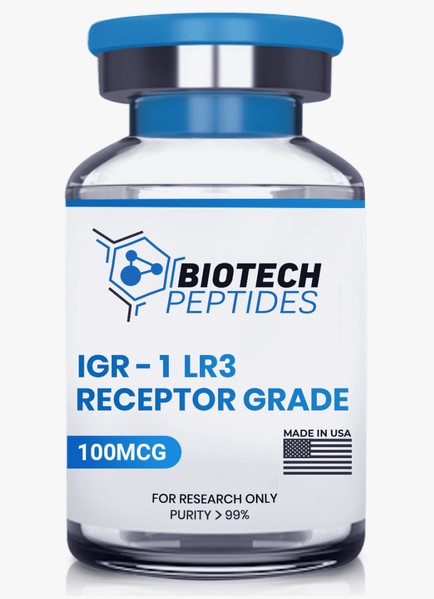

Insulin-like growth factor-1 (IGF-1 LR3), also known as Long Arginine 3-IGF-1, is a synthetic protein and an insulin-like growth factor-1 variant (IGF-1). LR3 has an arginine instead of a glutamic acid as the third amino acid in its amino acid sequence, unlike IGF-1. More powerful and lasting over a more extended period. In addition, research shows that the Receptor Grade IGF-1 LR3 peptide inhibits glucose entry into cells in the body, which aids in fat burning. This peptide, IGF-1 LR3, is potent and effective because of the rise in medical innovation and research.
What is IGF1 LR3?
A Growth Hormone product, IGF-1 LR3, is a variant of IGF-1 that stimulates cell growth all across the body, empowering growth and advancement, tissue strengthening, and increased bone density. There is a very little binding affinity for insulin-like growth factor-binding proteins in the IGF-1 LR3 research peptide, which has been shown to improve metabolic stability rapidly. As a result, it is thought to be three times as effective as IGF-1. As well, the half-life of the peptide is significantly greater than that of IGF-1, which is 12-15 hours.
What Is the Function of IGF1 LR3?
IGF-1 LR3’s primary function is to enhance IGF’s biological activity, according to research. Depending on the tissues in the body, the IGF-1 LR3 chemical performs different functions. For instance, the use of IGF-1 LR3 in muscle tissue increases the sensitivity of the muscle to insulin. However, while it has been shown to assist in fat loss, research has shown that it could also cause fat increase due to increased muscle mass.
In general, the human growth hormone (HGH) and IGF1 go hand in hand because HGH helps to keep tissues healthy in the body. Thanks to the pituitary gland, this long peptide can be made in the liver, which is located at the base of the brain. Its primary function is in the endocrine system, which helps regulate hormone production and release. This hormone triggers pregnant mice’s milk production, and the metabolism is boosted as a result. In addition, IGF1 LR3 plays a role in producing sex hormones and is essential to the growth of mice.
The Advantages of IGF-1 LR3
Peptide therapy with IGF1 LR3 has been shown to have several health advantages. Numerous studies have shown that IGF-1 lr3 injections work effectively if used consistently for three to six months.
Research has shown that IGF-1/LR3 peptide has the following advantages:
- Weight loss is aided.
- Reverses insulin sensitivity and accelerates metabolism, boosting energy levels and enhancing muscle growth and strength, respectively.
- Performance and desire to have intimate relationships are boosted.
- Eases sleeplessness and improves cognitive performance.
- Reduces symptoms of depression
IGF1 LR3’s Metabolic Effects
Similar to insulin, short-term use of IGF-1 LR3 stabilizes and lowers blood sugar levels.
According to their study, there was no difference in the hypoglycemic effects of IGF 1 and insulin when tested on eight healthy volunteers. After 30 minutes, there was the greatest drop in blood glucose levels: 1.98 ± 0.44 mmol per liter with IGF I and 1.78 ± 0.29 mmol per liter with insulin. Scientists may learn more about how to prevent type 2 diabetes by studying this.
Effects on Muscle Growth of IGF1 LR3
Growth hormone stimulates the production of the IGF-1 LR3 protein, which in turn triggers a cascade of cellular events. One of the reactions to the chemical is muscle growth.
IGF-1 LR3 promotes protein synthesis and nitrogen retention, according to recent scientific research. Hyperplasia (an increase in muscle cells) and mitogenesis (the creation of new muscle cells) contribute to the growth of muscles (the growth of new muscle fibers). As a result, research has shown that using IGF-1 LR3 for muscle growth can increase the size and number of muscle fibers. Research has shown that the peptide IGF-1 LR3 can genetically alter muscle tissue and cell count.